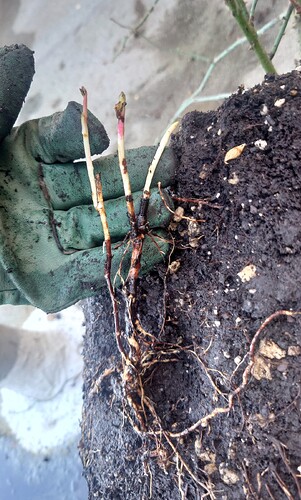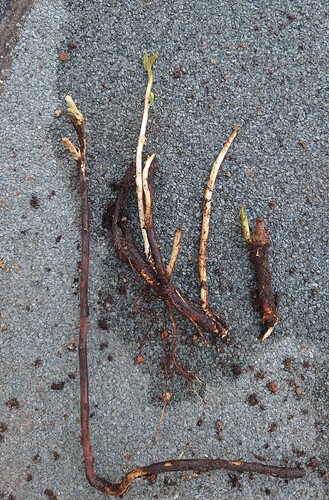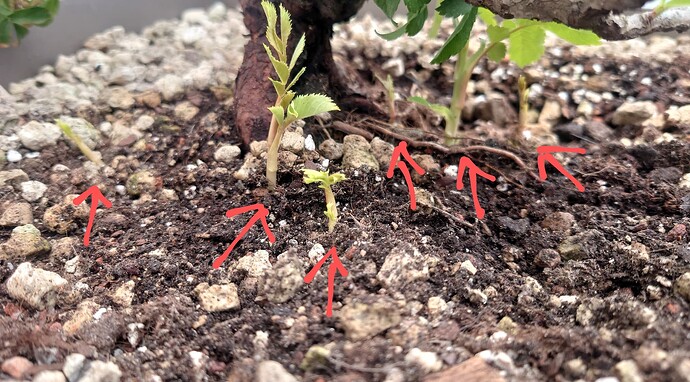Hi everyone,
I grow all my roses in pots, and almost all of them are grafted, all on “laxa” rootstock AFAIK.
Although I don’t mind ripping out the occasional sucker, two roses display excessive rootstock suckering that really inhibits the vigor of the grafted roses. I have to constantly watch for suckers and find myself removing them almost on a monthly basis. It’s getting annoying.
The other roses I grow from the same vendors (Loubert, Ruf) are perfectly fine. The pot size is the same as that of other grafted roses I grow and which don’t have this problem.
Are these particular rootstock plants just individual “bad apples”?
What is causing this excessive suckering and can anything be done to control it?
Can the grafted selection be grown on its own roots? That (rooting a cutting to replace the grafted plant) would be MY choice, and I may be forced to take this route with my own plant of ‘Quadra’, which has developed crown gall, in its pot.
Wrong person (me) to comment with authority because wrong climate - and now have very few grafted.
Those that were/are have suckers that come from below a union - that was buried at planting.
But curious and since forum is very quiet of late might as well try to kick start replies …….
My grafted roses (at the beginning of time) were usually thrashed (dead or weakened) every winter and l rationalize thats why l sometimes got/get large Huey plants that don’t bloom and huge tripod roots when l dig them out. The Huey root stock fighting to live - but canes not winter hardy here. So consistently regrows canes until l get fed-up with only green.
I assume that as you are an experienced grower etc. in a hot/warm climate year round, and the union is above soil line ?
Was grafted rose strong to start ? - before sucker plague. Is it still strong / normal with sucker pruning ?
If not, maybe union is flawed or damaged?
Anyways anything more from me is a stretch to fiction.
Good idea, thanks @VanIsleDWSmith !
I am very, very bad at rooting cuttings but I’ll give it a try anyway. ![]()
Hi @RikuHelin , thanks for your reply!
Yes the union is just above the soil line, and the suckers come from below. I think your theory that the union might be flawed or damaged could be a possibility. What can I do about that?
Both roses were growing well before the suckering started. Yanking out the suckers (I try not to cut them off because I read that makes it worse) gives the plant a boost in vitality for a while but soon it fades again as more suckers appear.
I am tempted to completely bare-root them to see what’s really going on down there. Even so, I’m not sure what that would accomplish, and I’m afraid root disturbance might encourage even more suckers, if that’s even possible. I think ll try it on one of them this weekend.
Unless someone comes up with a better idea might as well explore if it’s going to expire.
Just another thought, if past suckers have been “yanked” out if might worth thinking selecting digging down to the new connection and cleanly amputating at the connection to crown or trunk if originates on main “cane stub” of rootstock. Think l have read about that approach in past. Has to be practical though.
But a big pot could enable you to be in better control. I imagine pot sides can be a bit awkward as in prickle issues.
Just as aside some rootstock of mine ( dug out ) ended up showing ( grown) “ candelabras” forms (of dead canes) under ground. There was always a main thick sucker feeder from the original to the candelabra crown. I have suspicions these were “old yanks of mine”.
Again this is root stock, not root suckers from a good own root rose - they give me more roses l want.
But I eventually terminated a couple of own root Suzannes as they got out of hand. When a rose wants to sucker as it approaches “huge” l found it is a losing growing battle. Not encouraging, so you could substitute the phrase “ maintenance issue” … might be more palatable until you have had it.
I grow close so some roses had to go.
Hi SeasideRooftop,
to solve the problem permanently, you will probably have to take a rougher route. As you mentioned, it is indeed very important not to cut off the suckers as this could lead to new shoots. Furthermore it is essential that they are broken out completely with downward pressure (hammer, cold chisel). Any small part that remains will sprout again. If required, I use wound dressings or honey for protection afterwards.
I would additionally recommend very carefully removing some of the surrounding bark, which may contain dormant eyes. The best time is now, in early spring. I wish you every success!
Thanks so much @Roseus and @RikuHelin !
I’ll give it a try tomorrow. I hope it can solve the problem.
On one of the two roses, the suckers always seem to emerge in one area of the soil surface, so I expect it will be easier to identify and remove the point of origin. On the other rose, suckers appear all over the soil surface, so I expect it will be more complicated and perhaps several roots may need to be pruned. It will be an interesting investigation.
Many roses in my garden are getting ready to bloom. I hope these two will recover their vigor to join the chorus soon!
Done!
Thanks again Roseus and RikuHelin for the good advice!
The first rose was easy enough and as expected all suckers emerged from a single root. The second one was much more difficult with multiple roots suckering, one of them coming from deep inside the rootball and that short one came directly out of the main “carrot” of the rootstock near the crown. I did my best to remove them all as deeply as I could.
Both roses were also moved to bigger pots. I hope the problem is solved and they’ll have a good season!
Suckers on rose n°1 before removal:
Suckers from rose n°2 after removal:
Hello SeasideRooftop!
I’m sure a stone has fallen from your heart. I’m keeping my fingers crossed that the path is now open for a perfect season!
No way!
This is rose n°2… SIX new suckers popping up now!?!
It’s barely been three weeks since root pruning and repotting to a huge pot.
I’m now convinced the excessive suckering is a flaw of this particular individual rootstock specimen.
I think all that’s left to do will be @VanIsleDWSmith 's suggestion to take cuttings (after it blooms) and try to root them, and later just get rid of this grafted rose in the fall.
On the positive side, rose n° 1 seems fine!
Sounds like a good plan.
Hello SeasideRooftop!
That’s good news! I’ll keep my fingers crossed that it stays that way.
Rose n° 2: I’m sorry that the efforts didn’t work in this case. Perhaps some undeterminable stress factors or finally poor interactions between scion and rootstock are responsible for this reaction. However, I also believe that the proposed route is now the best one to preserve this rose. Good luck!


